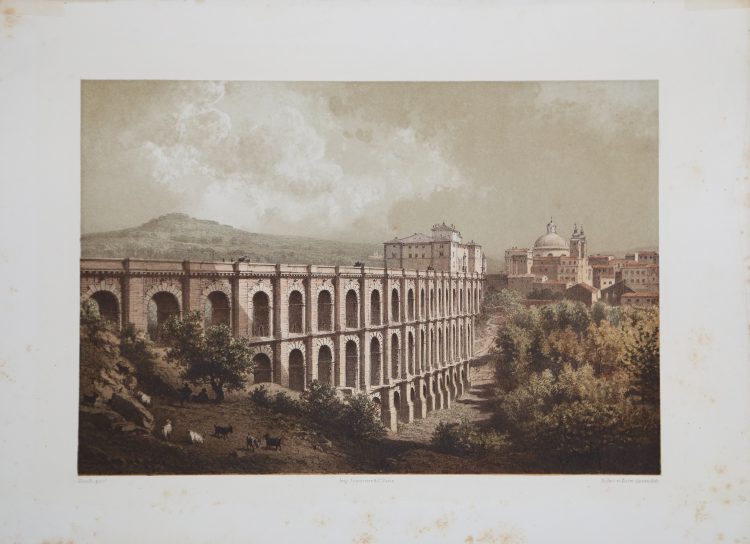



| Reference: | s13348 |
| Author | Joseph-Rose LEMERCIER |
| Year: | 1869 |
| Zone: | Ariccia |
| Printed: | Paris |
| Measures: | 320 x 215 mm |


| Reference: | s13348 |
| Author | Joseph-Rose LEMERCIER |
| Year: | 1869 |
| Zone: | Ariccia |
| Printed: | Paris |
| Measures: | 320 x 215 mm |
The plate is published in the famous Biographie du Souverain-Pontife Pie IX - by Francesco Massi, published in Paris in 1869 by Lemercier.
Joseph-Rose Lemercier (1803-1887) was one of the most important Parisian printers-lithographers of the 19th century. He worked for the greatest publishers and artists of his time. He played an important role in the diffusion and the generalization of the process of photolithography which made it possible to transfer a photographic image on a lithographic stone and to carry out thanks to that impressions with the printing ink of this image.
To a Francesco Massi listed as a Vatican writer and professor at the University of Rome is attributed a Biographie du souverain-pontife Pie IX, translated into French by Adrien Camusat de Riancey in volume I (Paris 1869, pp. 3-131) of the vast work edited by Victor Frond Actes et histoire du Concile oecuménique de Rome MDCCCLXIX, published in Paris in eight volumes between 1869 and 1873. Of this work, well documented and vividly written, there is no trace of the Italian text, nor is it cited by the early biographers of Massi" (cf. Gerardo Bianco - Dizionario Biografico degli Italiani - Volume 71, 2008).
Color lithograph, in perfect condition. Rare.
Joseph-Rose LEMERCIER (1803-1887)
|
Joseph-Rose Lemercier (1803-1887) was one of the most important Parisian printers-lithographers of the 19th century. He worked for the greatest publishers and artists of his time. He played an important role in the diffusion and the generalization of the process of photolithography which made it possible to transfer a photographic image on a lithographic stone and to carry out thanks to that impressions with the printing ink of this image. Of modest origin, son of a Parisian basket maker, he was born in Paris on July 6th 1803. He was apprenticed to Édouard Knecht, nephew and successor of Aloys Senefelder, the inventor of lithography. In 1828, he started his own business and in 1831, he moved to 57, rue de Seine, in a former game of paume.
Between 1852 and 1855, he joined forces with the optician Lerebours, the chemist Barreswil and the chemist and photographer Alphonse Davanne to develop such a process, but the result - of a too long and complex implementation - was not industrially exploitable. In 1855, Alphonse Poitevin invented and patented a process that could be used industrially. Poitevin first tried to exploit his patent himself and opened a workshop in Paris. However, in October 1857, he sold his patent and his workshop to Lemercier.
Lemercier works for all the great French publishers of his time. He is the printer of artists such as Odilon Redon, Édouard Manet and Alphonse Mucha. Joseph-Rose Lemercier was made a knight of the Legion of Honor in 1847, then promoted to officer in 1878. His nephew, Alfred Lemercier, succeeded him at the head of the company, then, at his death, inherited it.
|
Joseph-Rose LEMERCIER (1803-1887)
|
Joseph-Rose Lemercier (1803-1887) was one of the most important Parisian printers-lithographers of the 19th century. He worked for the greatest publishers and artists of his time. He played an important role in the diffusion and the generalization of the process of photolithography which made it possible to transfer a photographic image on a lithographic stone and to carry out thanks to that impressions with the printing ink of this image. Of modest origin, son of a Parisian basket maker, he was born in Paris on July 6th 1803. He was apprenticed to Édouard Knecht, nephew and successor of Aloys Senefelder, the inventor of lithography. In 1828, he started his own business and in 1831, he moved to 57, rue de Seine, in a former game of paume.
Between 1852 and 1855, he joined forces with the optician Lerebours, the chemist Barreswil and the chemist and photographer Alphonse Davanne to develop such a process, but the result - of a too long and complex implementation - was not industrially exploitable. In 1855, Alphonse Poitevin invented and patented a process that could be used industrially. Poitevin first tried to exploit his patent himself and opened a workshop in Paris. However, in October 1857, he sold his patent and his workshop to Lemercier.
Lemercier works for all the great French publishers of his time. He is the printer of artists such as Odilon Redon, Édouard Manet and Alphonse Mucha. Joseph-Rose Lemercier was made a knight of the Legion of Honor in 1847, then promoted to officer in 1878. His nephew, Alfred Lemercier, succeeded him at the head of the company, then, at his death, inherited it.
|